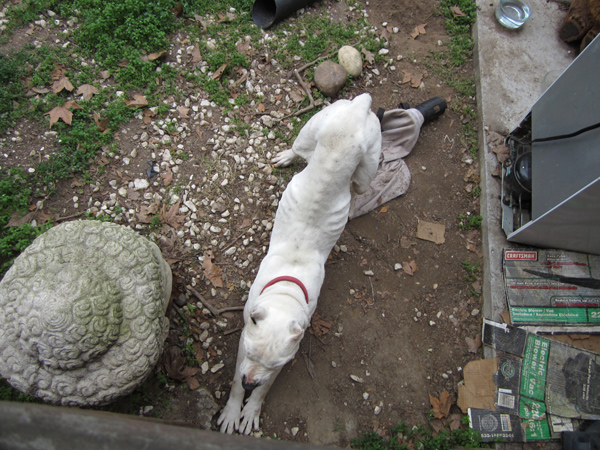
by Jesse Boyce, Humane Officer
Editor’s Note: The purpose of this series is to provide you, our readership, with an opportunity to experience the process that our investigators go through when conducting a complaint of animal abuse.If you have not done so, please read part 1.
I am facing a white dog with ribs, hips, and spine clearly visible, giving credence to the validity of the complaint that was received by the CCSPCA. The dog, a breed of which I cannot at the time pinpoint (it’s not a pit bull), places its nose against a space between fence boards to sniff at my offered palm. I can more clearly see the state that the animal is in, and fail to observe from my vantage point signs of water, food or shelter.
I circle the property and find no easy access to it. I stand on a block of wood to peer over the fence and into the back yard. The dog follows me along the fenceline, wagging its tail now, but giving no further alarm. It seems interested in me and friendly. I observe a bowl of water. I see neither food nor feces, which indicates that either the dog has not eaten in some time or the owner is cleaning up after it. Based on all facts available to me at the time, I determine that it is necessary that the dog be immediately seized and provided with veterinary care.
At that time I contact the Fresno Police Department and request that officers stand by while I seize the animal. Upon their arrival, the gate to the back yard is opened by unscrewing the latch. The dog, which I am later able to determine is a Dogo Argentino, greets me with wagging tail and licking tongue. I place him on my lead rope and walk him to my vehicle. I open the back of my truck and instantly he jumps in. A Notice of Seizure and Declaration of Ownership are left at the front door.*
I take the dog to the CCSPCA Small Animal Hospital where it is immediately examined by our staff. I will be notified by staff once the cause of his condition is determined.
(To be continued…)
*Penal Code 597.1(f) states that if an animal is in imminent distress (in need of immediate medical care) a notice of seizure must be posted at the main entrance to a property along with a Declaration of Ownership, enabling the owner to request a hearing to determine if the seizure was legal, if they wish to contest such seizure. This satisfies an individual’s right to due process when being deprived of personal property.